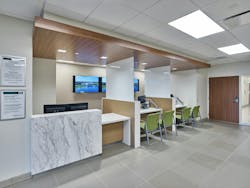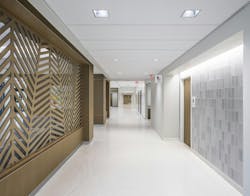Maximizing access for everyone: A closer look at universal design in healthcare facilities
It’s no secret that hospitals, inpatient rehabilitation facilities, medical office buildings and other healthcare centers often function as safe havens for their communities. Over the last few years, we have seen dramatic shifts in the way we design to create a sense of safety for various patient populations.
Research from the Academy of Neuroscience for Architecture has demonstrated that an enriched built environment can improve the patient experience. While not a new phenomenon, one strategy then can be used is universal design. At its core, universal design focuses on designing a space to make everybody feel welcome, regardless of their age, size or ability level, and they have equal access to the space—no one is a “special case.”
The Basics of Universal Design
Universal design includes seven core principles:
- Equitable Use: Can the design be used by people with a wide range of abilities?
- Flexibility in Use: Does the design accommodate a wide range of individual preferences and abilities?
- Simple & Intuitive Use: Is the design easy to understand, regardless of the user’s experience, knowledge, language skills or concentration level?
- Perceptible Information: Does the design communicate the necessary information to the user, regardless of sensory abilities?
- Tolerance for Error: Have hazards and the adverse consequences of accidental or unintended actions been minimized?
- Low Physical Effort: Can the design be used efficiently, comfortably, and with a minimum of fatigue?
- Appropriate Size and Space: Was the appropriate size and space allotted, and can things be reached regardless of physical mobility or size?
On the surface, these may seem like fundamentals that should be included in any space. Take Tolerance for Error for example—it is logical to think that we want our hallways and elevator lobbies to be free of objects that could cause someone to uses a cane to trip. But, when utilizing these principles, designers attempt to create empathy for those who often feel as though they are an afterthought in the design of a space. By using empathy to design an equitable space, we’re telling these individuals that we recognize the challenges they face and we want to alleviate that burden.
Designing Healthcare Spaces for Everyone
High-quality design for all requires research and innovation. With all of our healthcare projects, our firm starts by hosting collaborative work sessions to understand our clients’ priorities and needs and identify areas where we can optimize efficiency. When possible, we also conduct a post-occupancy evaluation to understand how the space is functioning to meet the end users’ needs.
Our Healthcare practice has found that there are five things that everyone needs from design: to feel safe, to feel included, to have the ability to focus, to be physically and cognitively comfortable and to have a sense of control over their situation. With an understanding of these needs, we’ve developed a set of healthcare design drivers to guide our practice. These include patient safety, adaptability/resiliency, operational efficiency, technology integration, the human experience, and sustainability. There are a number of ways these drivers manifest in the design of a healthcare space.
First, let’s look at the seating arrangements in waiting areas. Typically, singular chairs would be used to separate patients and give individuals a sense of personalized space. But, if we look at the principles of universal design, we can see that it might be better to use an alternative, such as double-wide chairs or a love seat, rather than specific bariatric seating, to accommodate people of size. By adapting to the needs of those who are not traditionally accounted for during the design process, we can create a more inclusive space.
Another good example can be seen in places of respite for clinical staff. Research has shown that nurses need a restorative recovery space so they can recharge during breaks. If properly designed, these spaces can also reduce rates of depression, prevent work burnout and minimize emotional and physical exhaustion. Rather than simply providing tables and chairs, designing a space that feels more like living-room style feel, complete with comfortable lounge furniture, coffee tables and inspiring artwork, can better support staff. These spaces will also help them feel cared for and acknowledged which could positively impact their behavior and help them excel at their job.
Empathy will Enhance Design
Being inclusive of all stakeholders in our design decisions will elevate our quality of design, creating a safe space that enhances the human experience for all. Using our healthcare design drivers, and the principles of universal design, we can help alleviate burdens for various patient populations and make certain that we provide a comfortable experience for all.
About the Author
Maria Sanchez is an experienced designer in the Architecture, Design, and Planning Industry—skilled in Revit, AutoCAD, Adobe Creative Suite, and Microsoft Office. She received her Master of Interior Design and Bachelor of Design with a minor in Sustainability and the Built Environment at the University of Florida. Maria aims to design user-centered environments that provide functional, sustainable and aesthetically appealing solutions for building occupants.
About the Author
Gresham Smith
The Gresham Smith blog is about starting discussions. We want to get people thinking about issues and trends that are impacting the design services industry and the market sectors Gresham Smith architects, engineers, interior designers, planners, consultants and environmental scientists serve. Great ideas are typically enhanced through conversation and often stifled by singular views and opinion. We hope you'll join in this conversation and help us to create a meaningful dialogue. Follow us on Facebook, Instagram, LinkedIn, Twitter, Vimeo, and YouTube.



